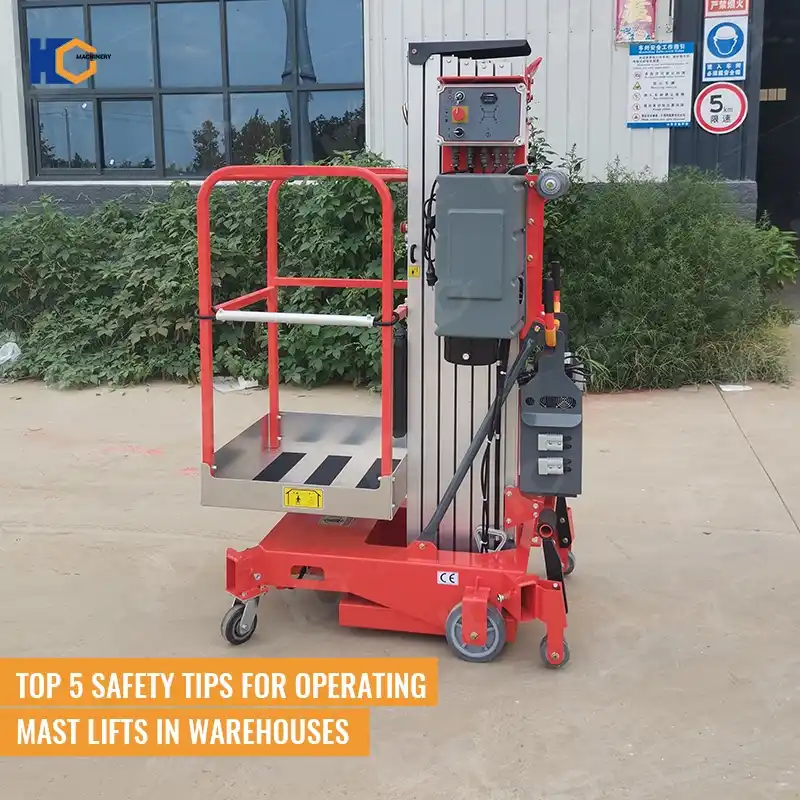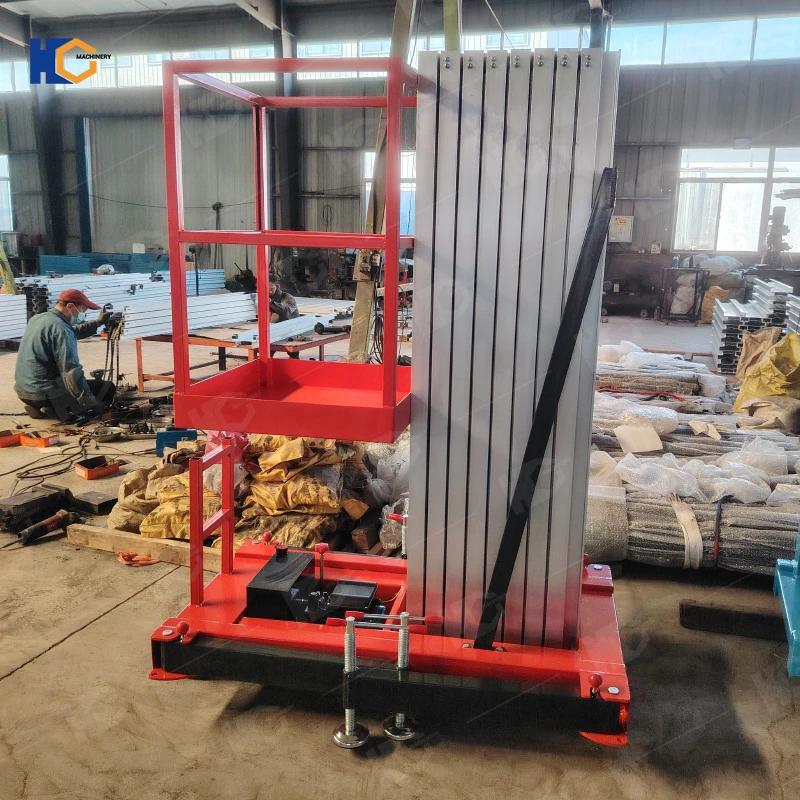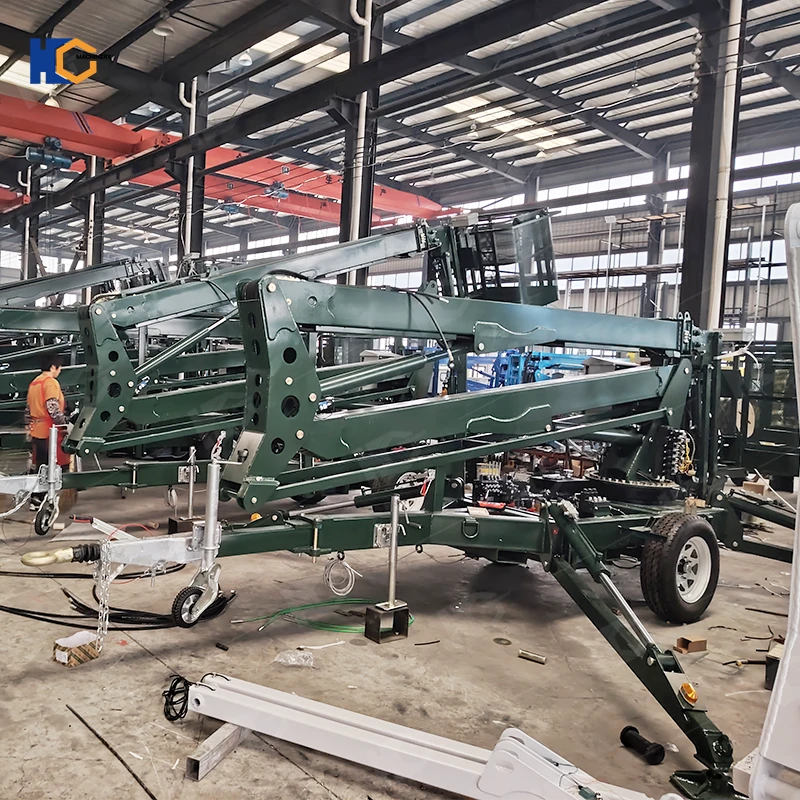Mast lifts, also known as vertical personnel lifts or material lifts, are essential equipment in modern warehouses and industrial facilities. These machines feature an extendable mast that allows workers to safely reach elevated storage areas, perform maintenance tasks, or handle high-level inventory. Unlike traditional forklifts, mast lifts are designed for vertical precision, making them ideal for narrow aisles, high-density storage systems, and order-picking operations.
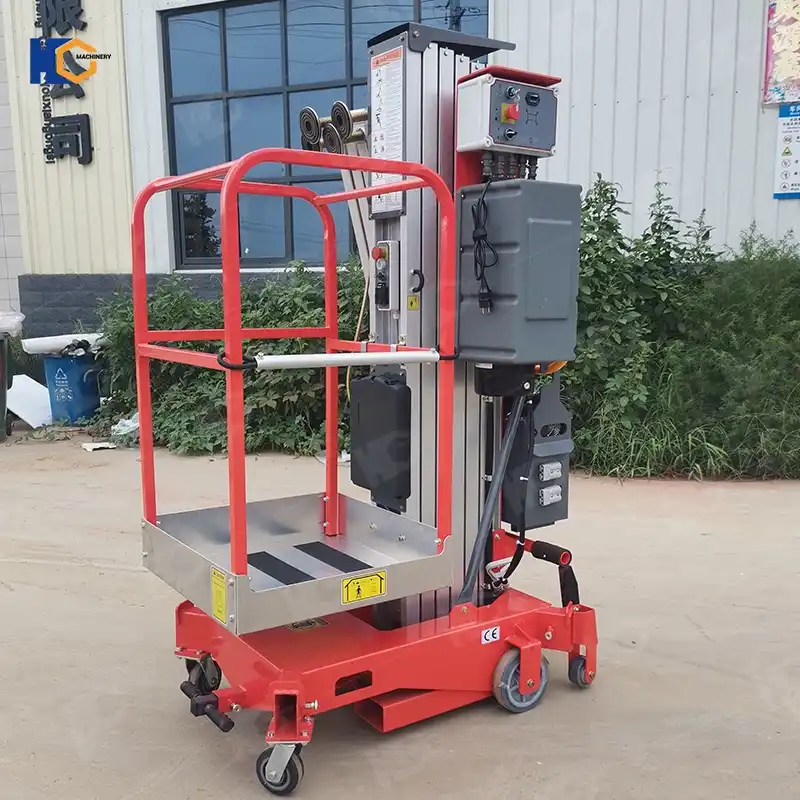
Why Mast Lift Safety Matters
Operating mast lifts comes with significant risks if proper precautions aren’t followed. According to OSHA (Occupational Safety and Health Administration), improper use of lifting equipment is a leading cause of warehouse accidents, including falls, tip-overs, and crushing injuries. Beyond regulatory compliance, enforcing strict safety protocols helps:
Prevent workplace injuries (protecting employees and reducing downtime).
Avoid costly OSHA fines by following compliance standards (e.g., 29 CFR 1910.178 for powered industrial trucks).
Improve operational efficiency—well-maintained and safely operated mast lifts reduce equipment failures and workflow disruptions.
Preview: Top 5 Mast Lift Safety Tips
To ensure safe and productive mast lift operations, warehouse managers and operators should prioritize these five critical safety measures:
Proper Training & Certification – Only qualified personnel should operate mast lifts.
Pre-Operation Inspections – Daily checks prevent mechanical failures.
Load Capacity & Stability – Avoid overloading and improper weight distribution.
Safe Operating Conditions – Clear pathways and watch for hazards.
PPE & Fall Protection – Essential gear for operator safety.
By following these guidelines, businesses can minimize accidents, extend equipment lifespan, and maintain a compliant, efficient warehouse environment. In the following sections, we’ll explore each tip in detail to help you implement best practices.
1. Conduct Proper Training & Certification for Mast Lift Operators
Operating mast lifts requires specialized skills and knowledge to ensure safety and efficiency in warehouse environments. According to OSHA standards (29 CFR 1910.178), all mast lift operators must complete formal training and certification before handling this equipment. Proper training covers critical aspects such as:
Load capacity limits – Understanding maximum weight restrictions to prevent tip-overs.
Control mechanisms – Mastering lift operation, including mast extension, lowering, and emergency stops.
Stability principles – Learning how load distribution affects balance, especially at height.
Emergency protocols – Responding to mechanical failures, power loss, or accidental drops.
Why Certification Matters
Untrained operators pose serious risks, including collisions, tip-overs, and falls—leading to injuries, damaged inventory, or OSHA violations. Certification ensures operators can:
Assess workplace hazards (e.g., uneven floors, overhead obstacles).
Perform safe maneuvers in narrow aisles or high-traffic zones.
React to emergencies (e.g., stabilizing a swaying load).
Ongoing Refresher Training
Even experienced operators need regular refresher courses (OSHA recommends every 3 years or after incidents). Updates may include:
New equipment features (e.g., automated safety sensors).
Regulation changes (e.g., updated OSHA forklift standards).
Reinforcing best practices to combat complacency.
Investing in thorough training reduces accidents, improves productivity, and ensures compliance—protecting both workers and warehouse operations.
2. Perform Pre-Operation Inspections for Mast Lifts
A thorough pre-operation inspection is the first line of defense against mast lift accidents and breakdowns. OSHA regulations require operators to conduct daily equipment checks before use, helping identify potential hazards before they escalate into costly incidents.
Key Components to Inspect
Hydraulic System
Check for fluid leaks (hoses, cylinders, connections).
Ensure smooth mast extension/retraction without jerking.
Brakes & Steering
Test brake responsiveness (both stationary and moving).
Verify steering alignment to prevent drift.
Tires/Wheels
Look for cracks, excessive wear, or punctures.
Confirm proper inflation (if pneumatic).
Controls & Safety Features
Test emergency stop buttons, horns, and lights.
Ensure safety guards (e.g., overhead cages) are secure.
Structural Integrity
Inspect the mast, platform, and welds for cracks or damage.
Check chains, cables, and pulleys for wear.
Red Flags to Never Ignore
Hydraulic fluid puddles → Potential system failure.
Unusual noises (grinding, squeaking) → Mechanical issues.
Erratic movements → Control malfunctions.
Action Plan for Faulty Equipment
Tag-Out Immediately: Place a "DO NOT OPERATE" sign on defective lifts.
Report Promptly: Notify supervisors/maintenance teams with details.
Document Issues: Log inspections to track recurring problems.
Pro Tip: Use a standardized checklist (see sample below) to ensure no step is missed.
Sample Pre-Op Checklist
✅ Fluid Levels (Hydraulic, Battery)
✅ Tire Condition & Pressure
✅ Functional Lights/Horn
✅ Safety Latch Engagement
✅ No Visible Damage
3. Follow Load Capacity & Stability Guidelines for Mast Lifts
Maintaining proper load management is critical for safe mast lift operation. Failure to adhere to weight and stability requirements accounts for 42% of all lift-related accidents according to OSHA incident reports. Follow these guidelines to prevent dangerous tip-overs and dropped loads:
Understanding Load Capacity
Always consult the manufacturer's data plate for maximum weight limits
Include the weight of:
The operator
All tools/equipment
The platform itself
Remember capacity decreases with height due to reduced stability
Proper Load Securing Techniques
Palletized Loads:
Use quality pallets without damaged boards
Secure with stretch wrap or banding
Loose Items:
Place in containers with secured lids
Use non-slip mats on platform surfaces
Specialty Loads:
Long items should be centered and balanced
Awkward shapes require extra tie-downs
Maintaining Stability
Center of Gravity Rules:
Keep loads centered on platform
Never allow overhang beyond guardrails
Distribute weight evenly across platform
Operational Best Practices:
Make slow, controlled movements
Avoid sudden stops/starts
Never use mast as a crane
Warning Signs of Instability:
⚠️ Mast vibration or shaking
⚠️ Uneven platform tilt
⚠️ Drifting when stationary
Emergency Response:
If instability occurs:
Immediately lower platform to lowest position
Secure load if safe to do so
Report incident to supervisor
Key Takeaway: A 5% overload can reduce stability by 30% - when in doubt, make two trips. Implement a color-coded weight verification system for quick visual checks.
4. Maintain Safe Operating Conditions for Mast Lifts
Creating and maintaining a safe work environment is crucial for preventing mast lift accidents. Over 60% of lift-related incidents stem from environmental factors according to National Safety Council data. Implement these protocols to ensure optimal operating conditions:
Workspace Preparation Checklist
Floor Surface Inspection:
Remove debris, tools, or loose materials
Mark and repair uneven surfaces/potholes
Clean oil/spills immediately (use absorbent materials)
Maintain minimum 3-foot clearance around lift perimeter
Traffic Management:
Designate separate pedestrian pathways
Install convex mirrors at blind corners
Implement one-way traffic systems in narrow aisles
Use floor markings to indicate lift operating zones
Spotter Protocols
When Spotters Are Required:
Visibility < 50 feet
Operating near racking systems
Working in active loading docks
Spotter Responsibilities:
Maintain visual contact with operator
Watch for approaching personnel/equipment
Communicate via standardized hand signals
Position themselves in operator's sightline
Overhead Hazard Management
Minimum Clearance Requirements:
10 feet for standard operations
15 feet when extending mast
Common Hazards to Identify:
Sprinkler systems (maintain 18" clearance)
Electrical conduits (minimum 3' distance)
HVAC ductwork
Racking beams/shelving
Proactive Safety Measures:
Conduct daily Job Safety Analysis (JSA) for lift operations
Install protective barriers around permanent obstacles
Use laser projection systems to mark danger zones
Implement "Look Up and Live" awareness program
Emergency Preparedness:
Keep aisles clear for emergency vehicle access
Post emergency shutdown procedures at all lift stations
Conduct quarterly evacuation drills including lift operators
5. Use Proper Personal Protective Equipment (PPE) for Mast Lift Operations
Proper PPE is the last line of defense for mast lift operators, reducing injury severity by up to 70% according to OSHA studies. A comprehensive PPE program should address these critical areas:
Essential Mast Lift PPE
Head Protection
ANSI-approved hard hats (Type II for top/side impacts)
Bump caps for low-clearance operations (where full hard hats aren’t feasible)
Fall Protection Systems
Full-body harnesses (OSHA 1926.502-compliant) with shock-absorbing lanyards
Anchor points rated for 5,000 lbs when working at heights ≥4 feet
Self-retracting lifelines for vertical mast applications
High-Visibility Gear
ANSI Class 2 or 3 safety vests in warehouse environments
Reflective striping for low-light conditions
Hand & Foot Protection
Puncture-resistant gloves (Level 4 cut protection)
Slip-resistant, steel-toe boots (ASTM F2413-18 compliant)
Specialized Protection Scenarios
Cold Storage: Insulated PPE with non-slip ice grips
Chemical Areas: Chemical-resistant aprons and face shields
Night Operations: LED light strips on harnesses
PPE Inspection Protocol
Daily harness checks for frayed straps/broken hardware
Monthly hard hat inspections for cracks/UV damage
Immediate replacement of worn gloves/shoes
Training Requirements
Annual donning/doffing demonstrations
Fit testing for harnesses (NFPA 1983 standards)
PPE hazard assessment documentation (OSHA 1910.132)
Conclusion: Prioritizing Mast Lift Safety in Your Warehouse
Operating mast lifts safely requires continuous vigilance and commitment to best practices. Let’s recap the 5 essential safety tips every warehouse team must implement:
Training & Certification – Ensure all operators are properly trained and OSHA-compliant.
Pre-Operation Inspections – Conduct thorough daily checks before use.
Load Capacity & Stability – Never exceed limits and maintain proper balance.
Safe Operating Conditions – Clear obstacles, use spotters, and watch for overhead hazards.
Proper PPE – Equip operators with helmets, harnesses, and high-visibility gear.
Consistency is key—safety isn’t a one-time effort but an ongoing culture. Encourage your team to:
Report hazards immediately (near-misses included)
Refresh training annually to combat complacency
Maintain equipment logs to track wear and repairs
By embedding these practices into daily operations, warehouses can reduce accidents by up to 60% (OSHA), boost productivity, and create a safety-first workplace.
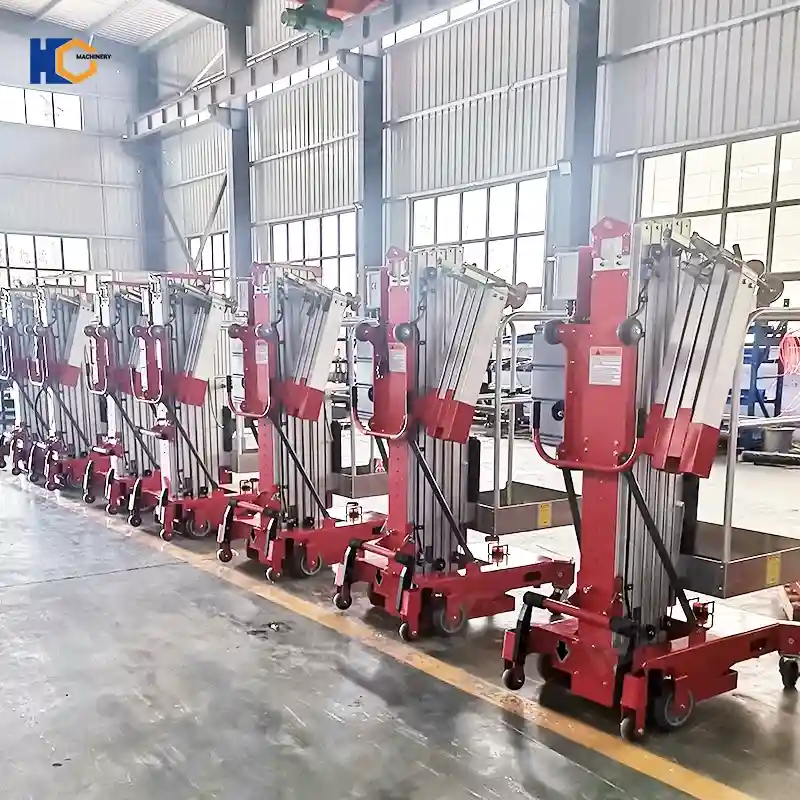
JNHC LIFT – Your Trusted Partner for High-Quality Mast Lifts
JNHC LIFT specializes in designing and manufacturing premium mast lifts for warehouse and industrial applications. Our lifts are engineered for durability, safety, and efficiency, helping businesses optimize vertical storage and material handling.
Why Choose JNHC LIFT?
✔ Robust Construction – Heavy-duty steel frames for long-lasting performance
✔ Advanced Safety Features – OSHA-compliant guards, emergency stops, and stability controls
✔ Custom Solutions – Configurable options for narrow aisles, high racks, and cold storage
✔ Low Maintenance – Reliable hydraulic and electrical systems
Ideal for order picking, inventory management, and logistics, JNHC mast lifts enhance productivity while ensuring operator safety. Contact us for a quote or consultation!
